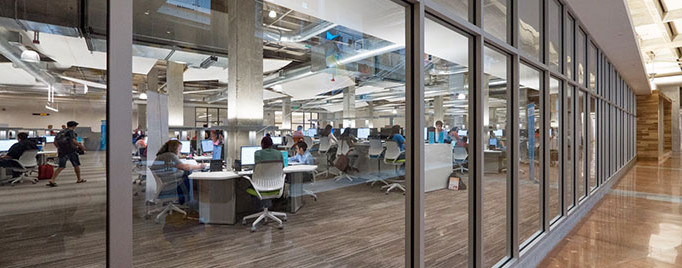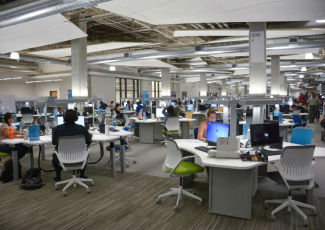Remedial Math Project Keeps Students Coming Back
By Rebecca L. Weber
March 30, 2015
Withdrawal rates are down as Austin Community College’s ACCelerator lets students work at their own pace and provides the support they need.
Experiencing Austin Community College’s ACCelerator math lab is sort of like visiting the Grand Canyon for the first time: “You can tell people how big it is, and see pictures, but they still have that moment when they arrive and say, ‘I’ve never seen anything like this before,’” says Stacy Guney, director of the project.
The 30,000-square-foot facility looks more like a cutting-edge tech company’s offices than a college’s computer lab with more than 600 stations. Check it out in this video.
https://www.youtube.com/watch?v=xHxq936GQoQ
In the ACCelerator’s inaugural semester, in fall 2014, the withdrawal rate for developmental math fell from 25 percent to 8 percent. Ninety-five percent of students who earned a “C” or better wanted to continue with the Assessment and LEarning in Knowledge Spaces (ALEKS) adaptive education program; 89 percent of unsuccessful students still said they wanted to give ALEKS another go.
“Basically, everybody, regardless of how well they did, wanted to come back and continue,” says Guney. “It’s very different from traditional classes, where we lose people.”
This current semester, 686 new students enrolled in developmental math, in which 397 students are returning.
While the ACCelerator sometimes serves more than 800 students in a day, it also has visitors from foundations and peer institutions. Jill Biden, wife of the vice president and a former English instructor at Delaware Technical & Community College, recently visited the ACCelerator during her trip to Austin’s SXSWedu summit, where she was a keynote speaker.
“I got shivers when I walked in,” Biden told ACC staff, referring to her visit to the ACCelerator. “I hope other community colleges come and see this and then adopt it on their own campuses.”
Setting the pace for success
In Fall 2014, the withdrawal rate for developmental math courses was about half the rate for traditional classes. For black and Latino students, the withdrawal rate was less than half of typical developmental math rates. One reason may be that students can work at their own pace, without knowing the progress of their classmates.
The math faculty favors “appropriately paced learning” over “self-paced.” Whatever the terminology, students control the pace; some move faster than in a traditional class. Last fall, nearly 45 percent completed the equivalent of one and a half courses, with 14 percent completing the equivalent of two courses.
A different model for remedial math
While some people see computers as devices that depersonalize the learning process, Guney says it’s the opposite — it’s “ultrapersonalized learning.” On the first day, students are escorted to their desks. They’re greeted by name, and instructors can always see exactly where the students are on the learning spectrum and speak to those needs.
Faculty members are self-selecting this shift in their pedagogy: Front-of-the-room lectures are out; time spent one-on-one with students is in. Math tutors roam around, looking for students who need individual attention.
Guney says a visit to an Apple Store, where there’s not really a line or a cashier, but there are people who are very present and looking to be helpful, served as inspiration. “It’s a different kind of retail experience. In a traditional classroom, it’s not that the people aren’t there to help you, but it’s structured around what the instructor wants the class to be about,” she says. “In this space, you can access any amount of different services.”
Guney has noted higher-than-normal levels of peer collaboration. “A lot of students have cohortized themselves as a byproduct of this space. They come to class beforehand and stay later. It’s not a regular classroom that has to turn over.”
Guney sees this as especially meaningful because ACC is a commuter college, where many students attend part time and don’t necessarily have a sense of belonging or continuity. “We don’t get a chance to build that community. It’s ironic, given our name,” she says. “This space is a place to come and stay. That’s helping a lot.”









